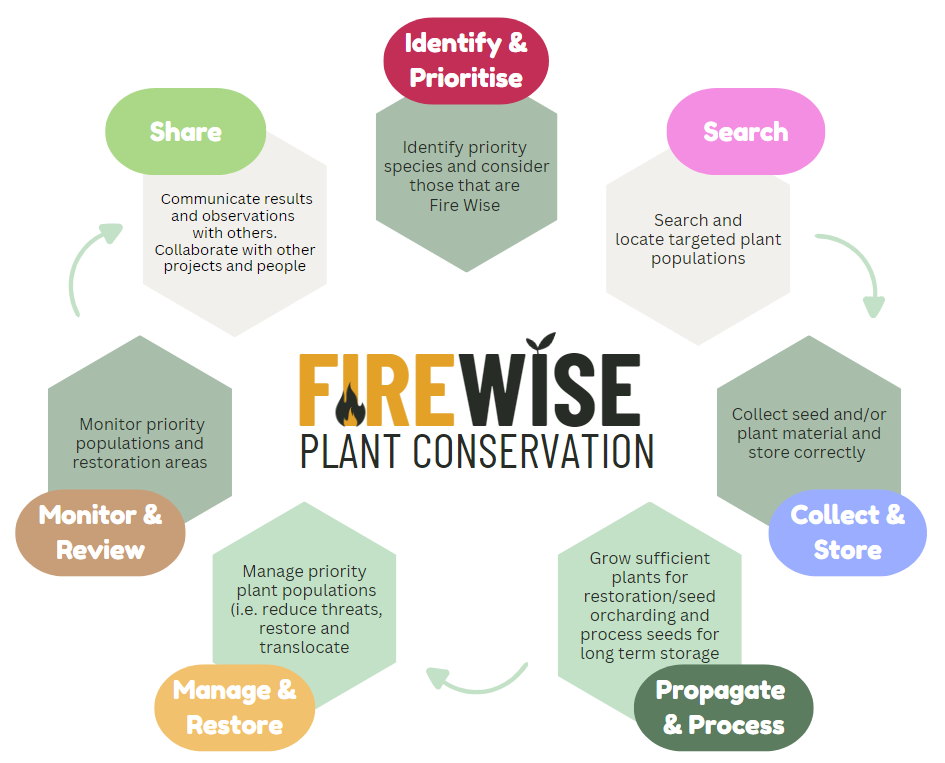Being Fire Wise
Encouraging the use of fire smart strategies to mitigate the effects of bushfires
About the Project
As part of The Foundation for National Parks & Wildlife’s (FNPW) Landscape Resilience Program, the NCS have developed educational material to help landholders and communities implement Fire Wise strategies to prepare the natural and built environments against bushfires. “Fire Wise” strategies involve those that have community and biodiversity resilience at their core; by being Fire Wise, communities can continue to live in fire-prone areas and safeguard their local environments for future generations.
Managing ecosystems for the co-existence of fire, biodiversity and people is an ongoing challenge.
Being Fire Wise involves understanding the complex and nuanced relationships between bushfires and biodiversity, particularly between bushfires and rare, endemic, and short-ranged plant species – it’s the latter that are most threatened with extinction. Complementary to the Kangaroo Island Rare Plant Garden, this project aims to protect Kangaroo Island’s unique threatened plant species by mitigating the harmful effects of bushfire.
Funding for this project is supported by the Foundation for National Parks & Wildlife and has received grant funding from the Australian Government through the Preparing Australian Communities local stream.
Fire Wise and Threatened Plant Conservation
Improving plant species and ecosystem resilience is one key strategy of being Fire Wise. Although the best way to conserve threatened plant species is to protect them and their habitats in the wild, other (ex-situ) conservation strategies can improve the resilience of species and/or vegetation communities.

There are several ways that ex-situ (off-site) threatened plant conservation may improve the resilience of species or vegetation communities:
- The establishment of seed banks or living collections play a role as an “insurance” population or seed source in a situation where all wild individuals of a species have been depleted or lost.
- When well planned, these seed banks and living collections can improve and conserve the genetic diversity of a species. Sometimes an ex-situ population can even host greater genetic diversity than the wild population, or maintain specific traits that have been lost from the wild population.
- This genetic variation has the potential to be reintroduced to the wild population through plant translocations, and hence improve the species’ resilience to altered fire regimes.
We have produced technical guidelines to support community to implement Fire Wise plant conservation, this includes:
- Fire Wise and Plant Conservation – why and how to conserve threatened plant species?
- Identifying and prioritising target plant species – what species should be prioritised and how to locate and record these?
- Seed collection and storage methods – what are the best practice methods?
- Plant germination and propagation – hot to maximise the success of germination and propagation?
- Restoration management and translocation – creating new plant populations to prevent extinction and monitoring success.
What We Did
On behalf of the Kangaroo Island Rare Plant Garden Fire Wise Project and the FNPW Fire Wise Project, the NCS produced educational material regarding the nature and practical implementation of Fire Wise strategies. In our document, “Fire Wise: Understanding Fire Ecology and Smart Restoration Strategies for Kangaroo Island”, we discussed the following topics:
- The causes and ‘three ingredients’ of bushfires
- Fire ecology
- The definition of Fire Wise
- How we can be Fire Wise
- Resilience strategies
- Fire Wise plant options
- Available resources
This information will help landholders and communities identify and implement wiser strategies into their bushfire management plans, to ensure the natural and build environments are better prepared against bushfires.
Contact us for a copy of this document
Why We Did It
We live in a time where bushfires are becoming increasingly frequent and intense. To better prepare communities and environments from the effects of bushfires, we must first understand the complex relationships between bushfire and our native Australian plant species, such as which plants are fire-resilient versus fire-sensitive. We must also understand the benefits in incorporating plants that are rare, threatened, and short-ranged.
While we can’t prevent all fires, we can take actions to decrease our vulnerability to them. We believe that resilience lies in community strength, which is guided by credible and understandable information. We want to activate and inspire communities to be the custodians of their own fire resilience strategies, and we understand that sometimes, it’s difficult to know where to turn. Our material provides landholders with the tools required to act, and live Fire Wise.
What We Learnt
- Biodiversity and bushfire resilience are complementary – by ensuring one, you often promote the other.
- Implementing a Fire Wise approach depends on an understanding of fire ecology – in other words, how fire interacts with aspects of the living and non-living environment.
- There are many Fire Wise plants that are native, rare, and threatened, and should be considered when planning planting and revegetation activities.
- Strategic landscaping and green firebreaks are effective Fire Wise strategies that can reduce or slow the spread of bushfires throughout the landscape.
Photos by Dean Lewins and Threatened Species Recovery Hub
Nature Conservation Society of South Australia
5 Milner Street Hindmarsh
South Australia, 5007
Australia
(08) 7127 4630
[email protected]
ABN 40 538 422 811
Follow us on


